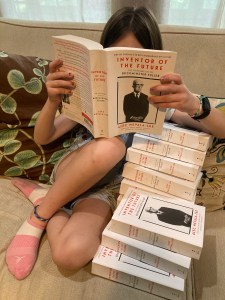Posts Tagged ‘New York Times Book Review’
Back to the Future

It’s hard to believe, but the paperback edition of Inventor of the Future: The Visionary Life of Buckminster Fuller is finally in stores today. As far as I’m concerned, this is the definitive version of this biography—it incorporates a number of small fixes and revisions—and it marks the culmination of a journey that started more than five years ago. It also feels like a milestone in an eventful writing year that has included a couple of pieces in the New York Times Book Review, an interview with the historian Richard Rhodes on Christopher Nolan’s Oppenheimer for The Atlantic online, and the usual bits and bobs elsewhere. Most of all, I’ve been busy with my upcoming biography of the Nobel Prize-winning physicist Luis W. Alvarez, which is scheduled to be published by W.W. Norton sometime in 2025. (Oppenheimer fans with sharp eyes and good memories will recall Alvarez as the youthful scientist in Lawrence’s lab, played by Alex Wolff, who shows Oppenheimer the news article announcing that the atom has been split. And believe me, he went on to do a hell of a lot more. I can’t wait to tell you about it.)
Burrowing into The Tunnel

Last fall, it occurred to me that someone should write an essay on the parallels between the novel The Tunnel by William H. Gass, which was published in 1995, and the contemporary situation in America. Since nobody else seemed to be doing it, I figured that it might as well be me, although it was a daunting project even to contemplate—Gass’s novel is over six hundred pages long and famously impenetrable, and I knew that doing it justice would take at least three weeks of work. Yet it seemed like something that had to exist, so I wrote it up at the end of last year. For various reasons, it took a long time to see print, but it’s finally out now in the New York Times Book Review. It isn’t the kind of thing that I normally do, but it felt like a necessary piece, and I’m pretty proud of how it turned out. And if the intervening seven months don’t seem to have dated it at all, it only puts me in mind of what the radio host on The Simpsons once said about the DJ 3000 computer: “How does it keep up with the news like that?”
Visions of tomorrow

As I’ve mentioned here before, one of my few real regrets about Astounding is that I wasn’t able to devote much room to discussing the artists who played such an important role in the evolution of science fiction. (The more I think about it, the more it seems to me that their collective impact might be even greater than that of any of the writers I discuss, at least when it comes to how the genre influenced and was received by mainstream culture.) Over the last few months, I’ve done my best to address this omission, with a series of posts on such subjects as Campbell’s efforts to improve the artwork, his deliberate destruction of the covers of Unknown, and his surprising affection for the homoerotic paintings of Alejandro Cañedo. And I can reveal now that this was all in preparation for a more ambitious project that has been in the works for a while—a visual essay on the art of Astounding and Unknown that has finally appeared online in the New York Times Book Review, with the highlights scheduled to be published in the print edition this weekend. It took a lot of time and effort to put it together, especially by my editors, and I’m very proud of the result, which honors the visions of such artists as H.W. Wesso, Howard V. Brown, Hubert Rogers, Manuel Rey Isip, Frank Kelly Freas, and many others. It stands on its own, but I’ve come to think of it as an unpublished chapter from my book that deserves to be read alongside its longer companion. As I note in the article, it took years for the stories inside the magazine to catch up to the dreams of its readers, but the artwork was often remarkable from the beginning. And if you want to know what the fans of the golden age really saw when they imagined the future, the answer is right here.
